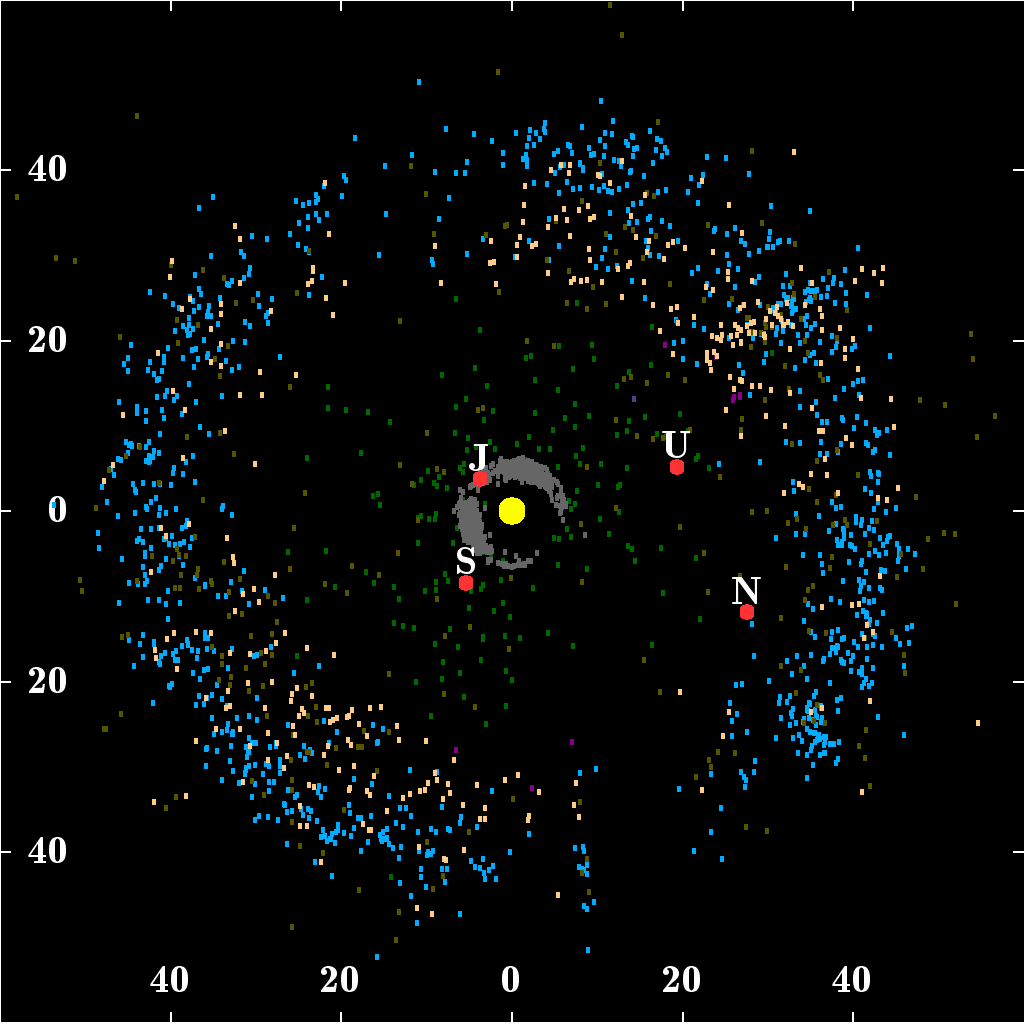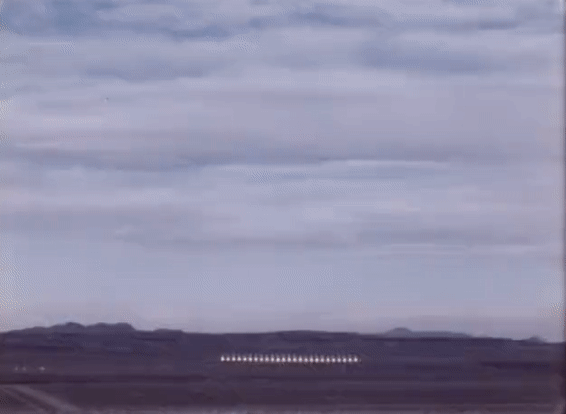|
Taiwanese–American Occultation Survey
The Taiwanese–American Occultation Survey (TAOS) is a robotic survey of the Outer Solar System. TAOS uses an array of four 50 cm aperture telescopes to monitor background stars awaiting the alignment of an Outer Solar System with a star target: an ''occultation''. Small objects in the Outer Solar System that are too small to be observed by direct observations at this time can be probed with this technique. Occultation surveys take advantage of diffraction effects during the transit of the occulting object (the ''occulter'') in front of a background star to constraint the size and distance of the occulter. TAOS is sensitive to occultations by Kuiper Belt Objects (KBOs) larger than about 500 m in diameter Z.-W. Zhang, F. B. Bianco, M. J. Lehner, N. K. Coehlo, J.-H. Wang, S. Mondal, C. Alcock, T. Axelrod, Y.-I. Byun, W.-P. Chen, K. H. Cook, R. Dave, I. de Pater, R. Porrata, D.-W. Kim, S.-K. King, T. Lee, H.-C. Lin, J. J. Lissauer, S. L. Marshall, P. Protopapas, J. A. Rice, ... [...More Info...] [...Related Items...] OR: [Wikipedia] [Google] [Baidu] |
Outer Solar System
The Solar SystemCapitalization of the name varies. The International Astronomical Union, the authoritative body regarding astronomical nomenclature, specifies capitalizing the names of all individual astronomical objects but uses mixed "Solar System" and "solar system" structures in theinaming guidelines document. The name is commonly rendered in lower case ('solar system'), as, for example, in the ''Oxford English Dictionary'' an''Merriam-Webster's 11th Collegiate Dictionary''. is the gravitationally bound system of the Sun and the objects that orbit it. It formed about 4.6 billion years ago when a dense region of a molecular cloud collapsed, forming the Sun and a protoplanetary disc. The Sun is a typical star that maintains a balanced equilibrium by the fusion of hydrogen into helium at its core, releasing this energy from its outer photosphere. Astronomers classify it as a G-type main-sequence star. The largest objects that orbit the Sun are the eight planets. ... [...More Info...] [...Related Items...] OR: [Wikipedia] [Google] [Baidu] |
Occultation
An occultation is an event that occurs when one object is hidden from the observer by another object that passes between them. The term is often used in astronomy, but can also refer to any situation in which an object in the foreground blocks from view (occults) an object in the background. In this general sense, occultation applies to the visual scene observed from low-flying aircraft (or computer-generated imagery) when foreground objects obscure distant objects dynamically, as the scene changes over time. If the closer body does not entirely conceal the farther one, the event is called a '' transit''. Both transit and occultation may be referred to generally as ''occlusion''; and if a shadow is cast onto the observer, it is called an eclipse. The symbol for an occultation, and especially a solar eclipse, is 🝵 (U+1F775 🝵). Occultations by the Moon The term occultation is most frequently used to describe lunar occultations, those relatively frequent occasions wh ... [...More Info...] [...Related Items...] OR: [Wikipedia] [Google] [Baidu] |
Diffraction
Diffraction is the deviation of waves from straight-line propagation without any change in their energy due to an obstacle or through an aperture. The diffracting object or aperture effectively becomes a secondary source of the Wave propagation, propagating wave. Diffraction is the same physical effect as Wave interference, interference, but interference is typically applied to superposition of a few waves and the term diffraction is used when many waves are superposed. Italian scientist Francesco Maria Grimaldi coined the word ''diffraction'' and was the first to record accurate observations of the phenomenon in 1660 in science, 1660. In classical physics, the diffraction phenomenon is described by the Huygens–Fresnel principle that treats each point in a propagating wavefront as a collection of individual spherical wavelets. The characteristic pattern is most pronounced when a wave from a Coherence (physics), coherent source (such as a laser) encounters a slit/aperture tha ... [...More Info...] [...Related Items...] OR: [Wikipedia] [Google] [Baidu] |
Kuiper Belt Objects
The Kuiper belt ( ) is a circumstellar disc in the outer Solar System, extending from the orbit of Neptune at 30 astronomical units (AU) to approximately 50 AU from the Sun. It is similar to the asteroid belt, but is far larger—20 times as wide and 20–200 times as massive. Like the asteroid belt, it consists mainly of small bodies or remnants from when the Solar System formed. While many asteroids are composed primarily of rock and metal, most Kuiper belt objects are composed largely of frozen volatiles (termed "ices"), such as methane, ammonia, and water. The Kuiper belt is home to most of the objects that astronomers generally accept as dwarf planets: Orcus, Pluto, Haumea, Quaoar, and Makemake. Some of the Solar System's moons, such as Neptune's Triton and Saturn's Phoebe, may have originated in the region. The Kuiper belt is named in honor of the Dutch astronomer Gerard Kuiper, who conjectured the existence of the belt in 1951. There were researchers before ... [...More Info...] [...Related Items...] OR: [Wikipedia] [Google] [Baidu] |
90377 Sedna
Sedna ( minor-planet designation: 90377 Sedna) is a dwarf planet in the outermost reaches of the Solar System, orbiting the Sun far beyond the orbit of Neptune. Discovered in 2003, the frigid planetoid is one of the reddest known among Solar System bodies. Detailed spectroscopic analysis has revealed Sedna's surface to be a mixture of the solid ices of water (H2O), carbon dioxide (CO2), and ethane (C2H6), along with occasional sedimentary deposits of methane (CH4)-derived, vividly reddish-colored organic tholins, a surface chemical makeup somewhat similar to those of other trans-Neptunian objects. Sedna has no detectable atmosphere, as its temperature is far too low for solids to volatilize. Within range of uncertainty, it is tied with the dwarf planet in the asteroid belt as the largest dwarf planet not known to have a moon. With a diameter of roughly 1,000 km, it is nearly the size of Tethys around Saturn. Owing to its lack of known moons, the Keplerian laws of ... [...More Info...] [...Related Items...] OR: [Wikipedia] [Google] [Baidu] |
Taiwan
Taiwan, officially the Republic of China (ROC), is a country in East Asia. The main geography of Taiwan, island of Taiwan, also known as ''Formosa'', lies between the East China Sea, East and South China Seas in the northwestern Pacific Ocean, with the China, People's Republic of China (PRC) to the northwest, Japan to the northeast, and the Philippines to the south. It has an area of , with mountain ranges dominating the eastern two-thirds and plains in the western third, where its Urbanization by country, highly urbanized population is concentrated. The combined Free area of the Republic of China, territories under ROC control consist of list of islands of Taiwan, 168 islands in total covering . The Taipei–Keelung metropolitan area, largest metropolitan area is formed by Taipei (the capital), New Taipei City, and Keelung. With around 23.9 million inhabitants, Taiwan is among the List of countries and dependencies by population density, most densely populated countries. Tai ... [...More Info...] [...Related Items...] OR: [Wikipedia] [Google] [Baidu] |
Lulin Observatory
The Lulin Observatory (, obs. code: D35) is an astronomical observatory operated by the Institute of Astronomy, National Central University in Taiwan. It is located at the summit of Mount Lulin in Xinyi Township, Nantou County. In 2007, Comet Lulin (C/2007 N3), was found by this observatory, and became the first comet discovered by a Taiwanese researcher. The minor planet 147918 Chiayi was also discovered here. The Lulin 1 meter had its first light in September 2002, after 10 years of development. Telescopes * LOT Cassegrain telescope (D=1-m, f/8) * SLT R-C telescope (D=0.40-m, f/8.8) by RC Optical Systems or ''76-cm Super Light Telescope (SLT)'' * Four TAOS robotic telescopes (D=0.50-m, f/1.9) Projects * Taiwanese–American Occultation Survey (TAOS) * Lulin Emission Line Imaging Survey (LELIS) *Exoearth Discovery & Exploration Network EDEN Lulin Sky Survey (LUSS) The Lulin Sky Survey searched for near-Earth objects from 2006 to 2009. The Lulin Sky Survey Tele ... [...More Info...] [...Related Items...] OR: [Wikipedia] [Google] [Baidu] |
Yushan National Park
Yushan National Park () is one of the nine national parks in Taiwan and was named after the summit Yushan, the highest peak of the park.Taiwan's National Park Website. The park covers a total area of 103,121 hectares that includes large sections of the Central Mountain Range. The park contains more than thirty peaks over in elevation, and two-thirds of the area within the park is above . The elevation difference in the park is , and there are many , cliffs, and [...More Info...] [...Related Items...] OR: [Wikipedia] [Google] [Baidu] |
Academia Sinica Institute Of Astronomy And Astrophysics
An academy (Attic Greek: Ἀκαδήμεια; Koine Greek Ἀκαδημία) is an institution of tertiary education. The name traces back to Plato's school of philosophy, founded approximately 386 BC at Akademia, a sanctuary of Athena, the goddess of wisdom and skill, north of Athens, Greece. The Royal Spanish Academy defines academy as scientific, literary or artistic society established with public authority and as a teaching establishment, public or private, of a professional, artistic, technical or simply practical nature. Etymology The word comes from the ''Academy'' in ancient Greece, which derives from the Athenian hero, ''Akademos''. Outside the city walls of Athens, the gymnasium was made famous by Plato as a center of learning. The sacred space, dedicated to the goddess of wisdom, Athena, had formerly been an olive grove, hence the expression "the groves of Academe". In these gardens, the philosopher Plato conversed with followers. Plato developed his sessions ... [...More Info...] [...Related Items...] OR: [Wikipedia] [Google] [Baidu] |
Lawrence Livermore National Laboratory
Lawrence Livermore National Laboratory (LLNL) is a Federally funded research and development centers, federally funded research and development center in Livermore, California, United States. Originally established in 1952, the laboratory now is sponsored by the United States Department of Energy and administered privately by Lawrence Livermore National Security, LLC. The lab was originally established as the University of California Radiation Laboratory, Livermore Branch in 1952 in response to the detonation of the Soviet Union's first atomic bomb during the Cold War. It later became autonomous in 1971 and was designated a national laboratory in 1981. Lawrence Livermore Lab is primarily funded by the United States Department of Energy, U.S. Department of Energy and it is managed Privately held company, privately and operated by Lawrence Livermore National Security, LLC (a Public-private partnerships in the United States, partnership of the University of California, Bechtel, BW ... [...More Info...] [...Related Items...] OR: [Wikipedia] [Google] [Baidu] |
National Central University
National Central University (; abbreviated NCU; ) is a public research university based in Taiwan. It was founded in 1902 in Nanjing; initially located in Miaoli after moving to Taiwan, it relocated to Zhongli in 1962 and developed into a comprehensive university. NCU is the first university in Taiwan to research industrial economics and economic development (Taiwan's Consumer Confidence Index is released monthly by NCU). NCU is a member of AACSB. NCU is one of the six national universities in research selected by the Ministry of Education, organized into eight colleges. History Established in 1902 as Sanjiang Normal School, National Central University underwent a number of name changes, such as Nanjing Higher Normal School, National Southeastern University and currently, National Central University. It was based in Nanking, but after the Chinese Communist Party took control of the mainland in 1949, the National Central University was re-established in Taiwan in 1962 as ... [...More Info...] [...Related Items...] OR: [Wikipedia] [Google] [Baidu] |




